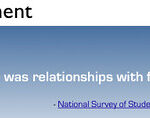Red Rover is an experiment with many layers. It’s a big vision made of many small steps.
Here’s where we are at what’s working, what’s an issue, what’s a real challenge, and our plans moving forward.
What’s Working:
The tag cloud/folksonomy architecture. Students can tag themselves. Many don’t know what “tags” are, but the interface is getting them to put 20 or so tags on themselves anyway. This is plenty to get started and make for useful and interesting comparisons.
The tag match recommendation. Students are finding groups on their campus and joining them. I’ve heard, “Wow, I’ve been on campus for three years and didn’t know [x group] existed.” That’s perfect – local discovery= increased engagement. Perfect. While there is very little baseline data available for comparison, what’s there suggests Red Rover is 2 – 4x more effective at connecting students to groups than the old methods.
Joining Groups. In our user survey, 63% of students found 2-4 groups that interested them, 58% spent time looking at recommended groups, 34% looked for more groups, and most importantly 64% of students joined one or more groups.
The social experience. Students like it. 81% said that they would recommend it to their friends despite the fact the interface and messaging both need work (see challenges below.)
The face-to-face conversation with schools and students. We are unique in that we are visiting many schools with Swift Kick training. We are actually talking to student affairs folk and student leaders constantly. We get their feedback, challenges, and hopes directly. The relationship matters, now (at startup when we are far from perfect) more than ever.
The Student Leader and Student Affairs Blogs due completely to the great people involved. Special thanks go to Tania Dudina and Debra Sanborn for leading the charge. We’re excited to spread the content and conversations via Red Rover.
What’s an Issue:
The interface. Simplicity and functionality are difficult to balance. To be successful it has to feel easy. Red Rover scores a C on this right now (down from a C+ when we had fewer features). 53% of respondents said sign up was easy, 30% said it was simple but long and 17% said they were confused. It’s also too “plain” according to the surveys. Students using Facebook and Google have come to expect/demand the best. We need to focus on this to get better numbers. We’re interviewing new team members to address this specifically.
Communicating the Value to students. We’re adding an additional context layer in between social (which the students want to do) and school (which they have to do – think Blackboard). Red Rover needs to start far more on the want side. We have cool personal comparison features (e.g. one-click, whole school, interest comparison) but it’s not enough of a video game to feel to register as entertainment. This is a part interface and part message clarity. Either way, it’s a pressing challenge. Students will spread “kind of cool,” but not nearly as fast as “really cool”. This brings us to:
Adoption. Our fall goal was 30% enrollment leading heavily towards freshmen at thirty schools. Three weeks into school we’re almost halfway there with about 7 schools, with many more in the 2-10% of enrollment range. I think the interface/clarity above will help, as will new invite/email features that just came out. With adoption, group density is paramount. Meaning that it’s almost pointless to talk about 300k installs, what matters is % of a single school or even % of a single class/year at a school. It’s the density that creates the “everyone is doing it” feeling and creates a good full dance floor feeling in groups – student groups or classes. No one seems to have cracked this yet. Not Courses 2.0, Course Feed, or even Blackboard. Our strategy was to try different adoption methods at different schools and disseminate best practices back to the schools – we’re still early with this.
What’s a Real Challenge:
Focus. Knowing we would be crossing a chasm with a free product, keeping our costs low was critical. (Meaning if we staffed up and free adoption took 2 years, we would have either needed to raise a decent amount or we would have run out of money.) This left us with not enough staff to maintain aggressive development speed and school support while traveling and training at the same time. It’s frustrating for us. There are more schools that would be farther along had we done a better job of proactively communicating about bugs and plans. We should have hired on contract for the July to November window. Not doing so was a mistake. We’re trying to hire for this spot now.
Free equals “if I have time” and very few have time. Student affairs folks get slammed on day one of school. Because Red Rover is free, I suspect the project fits into a muddy “would be nice” category – the same category as say, going home at a reasonable time (which also rarely happens). We’re working with great people in a tough position. We looked at charging for a joint experiment where charging would increase follow through and compared it to open, at will, a collaboration where our project might get put off. Most tech vendors choose option A. A few of these vendors have told us we would find Option B didn’t work in higher ed. We went with option B anyway. I do not believe this decision was a mistake. It allows for the student-led effort which will ultimately be the key. At this phase of the project, however, being lower on the list of priorities for our stakeholders presents a challenge. Especially when we are not doing a good job of proactively communicating.
Plans Moving Forward
1. Focus on communicating with our stakeholders. We know so many amazing people – staff, faculty, student leaders, and students. The user survey was listening, now we need to make it a conversation. We need to get our folks the info they need to participate. Specifics: more blogs here, increase phone call check-ins, new student leader newsletter, including application news in all newsletters.
2. Focus for 2 months on the user experience. We are slowing down new features development and focusing on making what we have easy, fun, and pretty. Specifics: hiring a user experience designer, 80% of time improving what is there, additional focus groups of students.
3. Hiring a support person. We are doing something very new. It’s understandable there would be hesitation and questions. Having a person dedicated to these questions will help.
4. Finish first-year experience curriculum. Scott Silverman, Coordinator, First Year Programs, UC – Riverside is heading up this project. It will embed identity development, college connectedness, and tech into the curriculum. Including Red Rover and Path101 for career planning. I’ll post more on this later. This is a solution to the adoption challenges.
5. Spread student government case studies. Tiq Chapa is launching Red Rover at Stanford as part of his student government responsibilities. This is an exciting direction. We will be telling this story, and the other launches by students, at the ASGA conference coming up shortly (Tom is keynoting).




